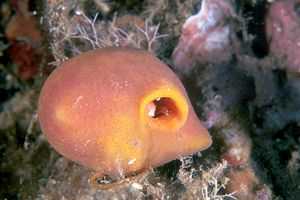Suberites domuncula
| Suberites domuncula | |
|---|---|
 | |
| Scientific classification | |
| Kingdom: | Animalia |
| Phylum: | Protista |
| Class: | Demospongiae |
| Order: | Hadromerida |
| Family: | Suberitidae |
| Genus: | Suberites |
| Species: | S. domuncula |
| Binomial name | |
| Suberites domuncula (Olivi, 1792) | |
Suberites domuncula is a sponge belonging to the Phylum Porifera.[1]
This species contains suberitine, a neurotoxin that can cause fatal hemolytic hemorrhaging in various animals. While it is highly toxic to fish, it is known to be preyed upon by the hawksbill turtle, Eretmochelys imbricata.[2]
There are currently two accepted subspecies of this taxon: Suberites domuncula domuncula and S. domuncula latus. In 1893, Lambe described a new sponge species as Suberites latus. This was later determined to be a junior synonym of S. domuncula and merged into the species as a subspecies under the scientific name S. domuncula latus.[1][3][4][5]
S domuncula is well known for colonizing gastropod shells occupied by hermit crabs. At least 13 species of hermit crabs have been found associated with this sponge. It has also been recorded attached to the shells of live gastropods and the carapace of other crustaceans.[6]
References
- ↑ 1.0 1.1 "Suberites domuncula". Integrated Taxonomic Information System. Retrieved 25 August 2007.
- ↑ Meylan, Anne (1988-01-12). "Spongivory in Hawksbill Turtles: A Diet of Glass". Science (American Association for the Advancement of Science) 239 (4838): 393–395. doi:10.1126/science.239.4838.393. JSTOR 1700236. PMID 17836872.
- ↑ "Suberites latus". Integrated Taxonomic Information System. Retrieved 25 August 2007.
- ↑ "Suberites domuncula domuncula". Integrated Taxonomic Information System. Retrieved 25 August 2007.
- ↑ "Suberites domuncula latus". Integrated Taxonomic Information System. Retrieved 25 August 2007.
- ↑ Jason D. Williams; John J. McDermott (2004). "Hermit crab biocoenoses: a worldwide review of the biodiversity and natural history of hermit crab associates". Journal of Experimental Marine Biology and Ecology 305: 1–128. doi:10.1016/j.jembe.2004.02.020.